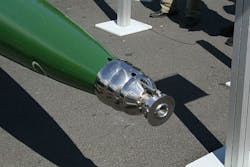Is world ready for an undersea missile? Supercavitating torpedo offers speed of 230 miles per hour
That kind of speed means a hypersonic missile could hit a target 100 miles away in little more than a minute -- not much time for countermeasures and evasive maneuvers. It's little wonder that speed is a top priority among military weapons developers.
Not everything military, though, is blazingly fast. Main battle tanks can roll at about 60 miles per hour over gentle terrain. A UH-60 Black Hawk helicopter cruises at about 174 miles per hour. A submerged attack submarine can go about 50 miles per hour flat-out -- we don't really know. These relatively slow systems typically don't have the notoriety of the fast ones. Still, they typically can shoot weapons that are very fast, like smart munitions, rockets, and soon even laser weapons.
How is it that the obsession for speed hasn't extended into the realm of undersea warfare? Submarines aren't too fast, but they shouldn't be. Their job is to lurk silently and undetected until that fateful moment when they launch a missile or torpedo.
Related: Supercavitation technology could enable super-fast future submarines and torpedoes
But what if a torpedo could move at 200 knots? That's 230 miles per hour -- not even close to supersonic, but still a mind-boggling speed underwater. A 200-knot torpedo essentially would be an underwater missile. Is this even possible, and if so, why don't we hear more about it?
Well, the underwater missile is real. It's called the supercavitating torpedo. The Russians have built one called the The VA-111 Shkval, which can reach underwater speeds in excess of 200 knots. Iran reportedly has developed a variant of the Russian Shkval called the Hoot. The German navy is credited with developing the Superkavitierender Unterwasserlaufkörper supercavitating torpedo, but it never went into production. The U.S. Navy is said to be toying with supercavitating torpedo technology.
These undersea missiles achieve their speed essentially by encasing the torpedo inside a bubble to eliminate the water's hydrodynamic drag. Once inside this bubble, and free of the water's drag, a rocket engine shoots the munition through the water faster than a NASCAR racer.
So why haven't supercavitating torpedoes come to revolutionize war at sea? It seems this technology also causes big problems with torpedo guidance, control, and precise targeting.
Conventional torpedoes steer themselves toward their targets with control surfaces that, in the water, act like an airplane's wings, rudder, and elevator in the air.
One big problem with supercavitating torpedoes is they can't stick control surfaces outside their protective bubble, lest the bubble bursts. No control surface contact with the water means no control of the torpedo; it goes in a stright line, period. This means they're prone to missing their targets.
Related: Navy asks Lockheed Martin to upgrade sonar subsystem in Mark 48 submarine-launched torpedo
Modern torpedoes home in on their targets with passive and active sonar. They must be able to hear the sound emitting from their targets, as well as a return signal from a sonar ping.
Supercavitating torpedoes don't have this advantage because they're really, REALLY LOUD -- too loud to hear much of anything. From a guidance standpoint it can't tell the difference between an enemy ship or submarine, and a rock formation.
So a supercavitating torpedo is fast, but it's also can't steer very well, and can't hear its target. Is it a viable weapon today? That's questionable. It's only been tested, and never used in combat.
All that could change, though, once someone figures out an efficient way to maneuver them, and enable them to home-in on their targets. Then they will be formidable weapons, and that day may not be too far off.
Ready to make a purchase? Search the Military & Aerospace Electronics Buyer's Guide for companies, new products, press releases, and videos


